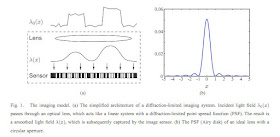Zhilin Zhang let me know of his advisor's ICASSP 2010 Tutorial slides: Sparse Signal Recovery: Theory, Applications and Algorithms by Bhaskar Rao and DavidWipf.
I have seen quite a few presentations on compressive sensing, but I think this picture quite beautifully explains what compressive sensing is to people who have done transform coding all their lives (wavelets, DCT...)
Yue Lu let me know that this is not compressed sensing but that it might be interesting, and sure enough it is: Gigapixel Binary Sensing: Image Acquisition Using Oversampled One-Bit Poisson Statistics by Feng Yang, Yue M. Lu, Luciano Sbaiz, Martin Vetterli. The abstract reads:
We study a new gigapixel image sensor that is reminiscent of traditional photographic film. Each pixel in the sensor has a binary response, giving only a one-bit quantized measurement of the local light intensity. To analyze its performance, we formulate the oversampled binary sensing scheme as a parameter estimation problem based on quantized Poisson statistics. We show that, with a single-photon quantization threshold and large oversampling factors, the Cram\'{e}r-Rao lower bound (CRLB) of the estimation variance approaches that of an ideal unquantized sensor, that is, as if there were no quantization in the sensor measurements. Furthermore, the CRLB is shown to be asymptotically achievable by the maximum likelihood estimator (MLE). By showing that the log-likelihood function of our problem is concave, we guarantee the global optimality of iterative algorithms in finding the MLE. Numerical results on both synthetic data and images taken by a prototype sensor verify our theoretical analysis and demonstrate the effectiveness of our image reconstruction algorithm. They also suggest the potential application of the oversampled binary sensing scheme in high dynamic range photography.
Some aspect of this work resemble that of epsilon-photography but I cannot help remember this story of the airy disk making a point and click camera was a compressive sensing system (see also weak compressive sensing).
Serguey Ten has his thoughts of perceptualashes and he is sharing them on twitter. While Eric Tramel wants to look into a simple implementation of this CSHash.
On the cell phone tracking for the E.coli outbreak, I received the following comments:
Peter is asking:
Igor, I'm curious, I haven't heard of anyone even asking for (or denying) the analysis of cell phone data. Do you have a reference? Google is not helping me because EHEC collides with the "cell phones = brain cancer" story...
I am merely suggesting that the data should be used and since I haven't heard anything about it in the media, I am expecting that nobody has really used them even though they are still available. In particular I would be very surprised if they collected that data of the non-residents since there is no European framework for that.
Tim rightly mentions the following point:
Using the mobile data to track individuals movements would partly be dependent upon the handset (3G iPhone, android etc) that supports location based services. With luck there will be many small packets of data for email or some data application. This would provide many frequent data points you could use to track detailed individual movements, say every 20 mins. If only voice calls and SMS/text are used, then there will be fewer points of data to work with and you will likely need many thousands of individuals (rather than 500) to build detailed insight.
What you describe is definitely a good idea, and not dissimilar to marketing analytics the telco might do themselves.
Cheers
http://timmanns.blogspot.com/
Yes getting the information directly from the handset might definitely be interesting as the data is in the owner's hand as opposed to giving permission to the German Telco. But I worry that not everybody has the latest GPS/smartphones. Still this is interesting.
In the meantime, it looks like the beansprouts are not the culprit so we are back to square one while the cell phone data still haven't been used. The Spaniards now think Germany owes them more than 200 million euros. Let me restate: if the outbreak was spread because of second hand contact none of these questionnaires and traditional epidemiology means are going to work. The cell phone data are our only way to get some idea as to where this is coming from.
In the meantime, it looks like the beansprouts are not the culprit so we are back to square one while the cell phone data still haven't been used. The Spaniards now think Germany owes them more than 200 million euros. Let me restate: if the outbreak was spread because of second hand contact none of these questionnaires and traditional epidemiology means are going to work. The cell phone data are our only way to get some idea as to where this is coming from.
Thanks Zhilin, Yue, Eric, Serguey, Tim and Peter!


No comments:
Post a Comment